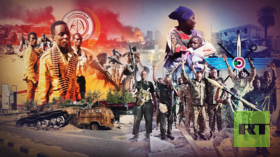Their first indirect talks in years offer a diplomatic opening, but deep mistrust and military preparations threaten progress
The United States and Iran have reopened high-level diplomatic talks over Tehran’s nuclear program, holding their first indirect negotiations in years. The meeting took place in Muscat, Oman, with Iranian Foreign Minister Abbas Araghchi leading Tehran’s delegation and US Special Presidential Envoy Steve Witcoff representing Washington. This marks the highest level of engagement between the two nations since 2018.
The talks were conducted via shuttle diplomacy: the two delegations were housed in separate rooms, with Oman’s Foreign Minister Badr bin Hamad al-Busaidi acting as the go-between.
Following the session, Araghchi described the meeting as a constructive first step. “For a first round, the discussions were positive,” he said in an interview with Iranian state television. “They were held in a calm, respectful environment, free from inflammatory language. Both sides seemed committed to moving the process forward toward a workable agreement.”
The White House echoed this sentiment in a brief statement, describing the talks as “very positive and constructive.” It emphasized that Witcoff had been instructed to pursue diplomacy wherever possible and work toward resolving disagreements through dialogue.
President Donald Trump, when asked about the talks by reporters, offered a guarded endorsement. “I think they’re going well,” he said. “But nothing matters until it’s done. I don’t like talking about it too much. Still, it’s moving along.”

Diplomacy without trust
Despite his aggressive rhetoric and an expanded US military presence in the region, Trump has continued to express an interest in diplomacy. He announced the resumption of talks while seated beside Israeli Prime Minister Benjamin Netanyahu – an especially significant moment, as Netanyahu likely anticipated a stronger show of support for possible military action against Iran’s nuclear infrastructure.
Instead, Trump emphasized the need for negotiation, signaling either a strategic pause or possibly a broader plan that prioritizes political leverage over immediate confrontation.
In Tehran, officials have responded with skepticism. Although Iran has never entirely ruled out dialogue with the West and had hoped for a diplomatic thaw, state-affiliated media outlet NourNews framed Trump’s comments as a “psychological operation” aimed at shaping a narrative that benefits Washington both at home and abroad.
Iran, for its part, is approaching talks with a pragmatic but firm set of demands. Officials have outlined clear conditions that must be met before any deal can be reached. Chief among them: lifting key sanctions – particularly those affecting the energy and banking sectors – unfreezing Iranian assets held in foreign banks (notably in Europe and East Asia), and securing firm guarantees against future US or Israeli military strikes.
These demands reflect deep-rooted distrust. From Tehran’s perspective, the US withdrawal from the 2015 nuclear deal – despite Iran’s compliance and its acknowledgement by US allies like the UK, Germany, and France – stands as proof that Washington’s commitments can’t be trusted.
Whether the US is prepared to meet Iran’s terms remains uncertain. Trump has long portrayed himself as a leader who can strike deals and avoid drawn-out wars, a narrative that plays well with his political base. But his track record with Iran suggests otherwise. The US has repeatedly walked away from agreements without meaningful consequences, reinforcing the Iranian view that verbal or even signed commitments from Washington are not strategically reliable.
This gap between rhetorical diplomacy and concrete guarantees is now front and center. Tehran insists on binding, measurable terms. But from Washington’s perspective, offering sweeping concessions could be seen as a loss of leverage. That puts both sides at an impasse: Iran is asking for assurances the US is reluctant to give, while the US expects compromise from a country whose regional influence has diminished.

Iran’s negotiating position has indeed weakened. A decade ago, it could rely on a strong network of regional proxies – Hezbollah in Lebanon, Hamas, and various Shiite groups in Iraq and Syria. Today, many of those assets have been degraded or sidelined. While Iran still holds sway in Iraq, even Baghdad is now pursuing a more balanced foreign policy that includes closer ties with the US, Gulf nations, and Türkiye, further limiting Tehran’s regional reach.
In short, Iran is making maximalist demands from a position of reduced leverage. That makes it unlikely Washington will grant significant concessions in the near term. Both sides are stuck: Iran is pushing for guarantees the US doesn’t want – or isn’t able – to give, while the US expects flexibility from an increasingly isolated adversary.
Which raises the looming question: What if talks collapse?
War scenarios
We cannot completely dismiss the assumption that Trump may be using diplomacy to set the stage for a military confrontation. His administration’s past actions – exiting the 2015 deal, ordering the assassination of General Qassem Soleimani, expanding sanctions, and reinforcing US military positions in the region – have consistently undercut chances for dialogue. So while these talks may be genuine, they could also serve to justify future military action if diplomacy fails.
Analysts believe Washington is considering two main options for striking Iran’s nuclear infrastructure, especially in Natanz and Fordow. One scenario involves a joint operation with the Israeli Air Force. The other envisions a solo Israeli strike. In either case, precision airstrikes involving advanced munitions are expected.
Iran’s air defense systems are unlikely to repel such an assault – especially if the US deploys B-2 stealth bombers or GBU-57 bunker-busting bombs. A full-scale strike could seriously damage both above-ground and underground facilities.
Historically, Iran has relied on asymmetric retaliation, targeting adversaries through non-conventional means. But its ability to respond this way has eroded. Hezbollah has sustained major losses amid stepped-up Israeli military campaigns, and Syria – once a linchpin of Iran’s strategy under Bashar al-Assad – has effectively fallen under the influence of Tehran’s rivals.
Given this shift, Iran would likely rely primarily on its own resources in any counter-strike. While more isolated than before, it still wields a diverse array of tools: ballistic missiles, attack drones, cyber capabilities, and regional proxy operations.

One probable form of retaliation would be missile and drone strikes on Israel. That’s not just speculation – Tehran executed limited but unprecedented attacks in 2024. In one case, it launched roughly 200 missiles, some of which bypassed Israeli air defenses and hit Nevatim Air Base. These actions signaled Iran’s intent and capacity to respond forcefully. While Israel maintains one of the world’s most advanced air defense systems, such attacks could still carry serious political and strategic consequences.
American bases in the region are also potential targets. The US maintains a sprawling military footprint across the Middle East – including in Iraq, Qatar, Kuwait, Jordan, Bahrain, and Saudi Arabia – with roughly 40,000 troops stationed there as of late 2024. These facilities have already been hit by Iran-backed groups. In January, a drone launched from Iraqi territory breached US defenses in Jordan, killing three service members. Iran also retaliated for Soleimani’s killing in 2020 by launching direct missile strikes on two American bases in Iraq, resulting in dozens of concussions among personnel.
Compared to Israeli targets, US bases are generally closer to Iran and its regional proxies – and less well-protected – making them attractive targets for both conventional and asymmetric retaliation. Still, striking US forces carries far greater risks, potentially triggering an overwhelming American response.
In line with its asymmetric playbook, Iran might also seek to apply pressure through regional partners. Gulf nations such as Saudi Arabia, the UAE, Qatar, Bahrain, and Kuwait – key logistical and military allies of the US – could find themselves in the crosshairs. Iran has already warned these governments that allowing American forces to use their territory or airspace would be seen as an act of war. However, attacking these countries directly would carry high stakes, particularly in light of Iran’s recent diplomatic thaw with Riyadh in early 2023. Should Iran pursue this path, it’s more likely to focus its retaliation on US assets rather than Arab infrastructure.
Another element in Tehran’s deterrence playbook is the threat to close the Strait of Hormuz – a critical choke point for global oil and LNG shipments. Around 20% of the world’s oil exports and more than 30% of all liquefied natural gas passes through this narrow corridor. Any blockade could cause energy prices to spike and throw global markets into turmoil.
Still, such a move could backfire. Iran’s economy depends heavily on oil and gas exports, and disrupting that flow would cut into its own revenues. A closure would also risk damaging relations with key economic partners – especially China, the largest buyer of Iranian oil. Unlike the US, China’s energy security is directly tied to Hormuz’s stability, and any disruption could be seen as a threat to Beijing’s national interests.
***
At this point, all eyes are on whether the talks can gain even modest traction. A minimal diplomatic breakthrough could delay – or even prevent – the kinds of escalatory measures now being discussed.
In a region where the stakes are as high as the distrust is deep, even small steps toward diplomacy might be a best-case scenario – for now.

